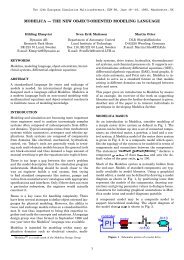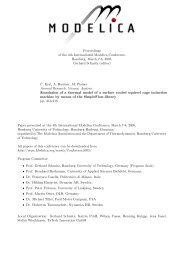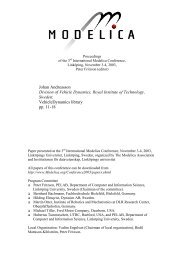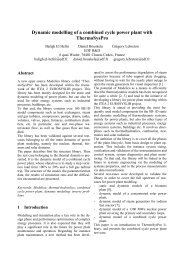Implementation of a Modelica Library
Implementation of a Modelica Library
Implementation of a Modelica Library
You also want an ePaper? Increase the reach of your titles
YUMPU automatically turns print PDFs into web optimized ePapers that Google loves.
Use <strong>of</strong> <strong>Modelica</strong> language to model an MV compensated electrical<br />
network and its protection equipment : comparison with EMTP<br />
Abstract<br />
Olivier Chilard Jean-Philippe Tavella Olivier Devaux<br />
EDF Research and Development<br />
1, avenue du général de Gaulle, 92140 Clamart France<br />
olivier.chilard@edf.fr jean-philippe.tavella@edf.fr olivier.devaux@edf.fr<br />
Today, neutral compensation based on Petersen coils<br />
is being applied in many MV electrical networks.<br />
The main reasons for this are :<br />
- an important expansion <strong>of</strong> the underground network<br />
in rural environment. This leads to high<br />
phase-to-ground capacities <strong>of</strong> the outgoing feeders,<br />
which increases fault currents in networks<br />
using impedant grounding,<br />
- an increased sensitivity <strong>of</strong> the customers to the<br />
quality <strong>of</strong> supply,<br />
- changes in international standards (insulation<br />
coordination).<br />
The introduction <strong>of</strong> arc suppression Petersen coils<br />
allows both to reduce the current in single phase-toground<br />
faults and to improve the quality <strong>of</strong> supply by<br />
reducing short supply disconnection.<br />
Adapting this solution to the existing networks made<br />
it necessary to change the protection system, by using<br />
zero sequence wattmetric relays.<br />
The feedbacks <strong>of</strong> the zero sequence wattmetric relays<br />
operating today show the need <strong>of</strong> an evolution<br />
<strong>of</strong> this protection equipment specifications. To address<br />
this need, EDF R&D has investigated the use<br />
<strong>of</strong> <strong>Modelica</strong> language for the electrical system modeling.<br />
At first the relevance <strong>of</strong> <strong>Modelica</strong> language for electrical<br />
systems modeling has been studied. This work<br />
was made from a comparison <strong>of</strong> simulation results<br />
with those traditionally obtained with EMTP s<strong>of</strong>tware,<br />
normally used by EDF R&D. This paper details<br />
this approach and underlines the interest <strong>of</strong><br />
<strong>Modelica</strong> for the electrical network fields. The next<br />
step will be the use <strong>of</strong> the <strong>Modelica</strong>ML pr<strong>of</strong>ile in<br />
order to establish a new version <strong>of</strong> the protection<br />
system specification.<br />
1 Introduction<br />
Currently, in order to design new control devices<br />
such as protection equipment, Matlab and EMTP are<br />
widely used. The solutions obtained are then validated<br />
on the field. Once a final solution is retained, a<br />
specification paper is then written and sent to the<br />
manufacturers which provide industrial solutions.<br />
However, paper specifications are not formal,<br />
thus they may be interpreted differently by manufacturers<br />
and lead to some difficulties in conception<br />
phases. Moreover, when an equipment has been in<br />
operation for several years, if the initial solution has<br />
to be upgraded, the initial specification paper might<br />
be difficult to exploit again. Indeed, the informal<br />
description <strong>of</strong> the expected equipments <strong>of</strong>ten leads to<br />
a paper with redundant, missing or interpretable requirements.<br />
In this context, a new approach based on the<br />
<strong>Modelica</strong> language has been studied. <strong>Modelica</strong> has<br />
been applied first in the particular case <strong>of</strong> the zero<br />
sequence wattmetric relay used in MV compensated<br />
networks. Moreover, this approach is intended to be<br />
used both for the development and specification<br />
phases.<br />
This paper presents the modeling work and gives<br />
a comparison with a more traditional approach using<br />
EMTP-RV [3]. The simulation results are also provided<br />
and compared.<br />
The final objective will be to provide a formal<br />
executable specification <strong>of</strong> the expected equipment.
2 Description <strong>of</strong> the use case retained<br />
The use case refers to the modeling and the simulation<br />
<strong>of</strong> two zero sequence wattmetric protections<br />
and a simplified MV compensated network. The protection<br />
is described in a specification paper established<br />
by EDF R&D. It has been developed to protect<br />
MV neutral compensated networks against mean<br />
and medium resistive single phase faults. This protection<br />
denoted PWH, is based on the analysis <strong>of</strong><br />
both transient and steady state values <strong>of</strong> residual current<br />
and residual voltage available in the compensated<br />
MV substation.<br />
Let’s briefly recall the principle <strong>of</strong> a compensated<br />
network and that <strong>of</strong> the PWH.<br />
In rural MV distribution networks, each feeder is<br />
mainly constituted <strong>of</strong> an overhead line and thus,<br />
when a fault occurs, the phase-to-ground capacitance<br />
current values are low (Figure 1). Therefore in these<br />
cases the neutral <strong>of</strong> the HV/MV transformer is<br />
grounded through a resistor and the fault current is<br />
equal to the neutral current.<br />
Figure 1 : Principles <strong>of</strong> compensated networks<br />
In mixed MV Distribution networks, an important<br />
part <strong>of</strong> each outgoing feeder is composed <strong>of</strong> underground<br />
cables. Therefore, contrary to the previous<br />
case, when a single fault occurs, the total capacitor<br />
current value seen at the MV busbar is important.<br />
Thus the resistor <strong>of</strong> the MV neutral grounding is replaced<br />
by a coil (a resistor in parallel with an inductor,<br />
refer to Figure 1) in order to compensate the zero<br />
sequence capacitor current and thus limit the current<br />
according to the international standard (insulation<br />
coordination). Consequently, if the mismatch <strong>of</strong> the<br />
coil is adjusted to zero Amps, the fault current is limited<br />
to the active neutral current part <strong>of</strong> the coil.<br />
Concerning the network modeling, a simplified<br />
MV compensated network is considered. The following<br />
assumptions are made :<br />
- The single phase fault is considered close to<br />
the MV busbar. Thus, the reactance <strong>of</strong> each<br />
outgoing feeder is neglected and only the<br />
phase-to-ground capacitance is considered,<br />
- The MV substation three phase voltage<br />
source is assumed to be balanced,<br />
- Consumption and reactive power compensators<br />
are not considered.<br />
Figure 2 : MV compensated network retained<br />
Therefore, the simplified MV network scheme retained<br />
is given in Figure 2. The substation is defined<br />
by its HV/MV transformer, its coil inserted on the<br />
neutral grounding and its MV busbar. One faulty<br />
feeder and two unfaulty feeders are considered. The<br />
second unfaulty feeder (without protection)<br />
represents an aggregation <strong>of</strong> all other unfaulty feeders.<br />
Two PWHs are also considered and respectively<br />
allocated to the faulty feeder and to the first unfaulty<br />
feeder (Figure 2). Its aim is to eliminate the single<br />
phase fault. To do that, the PWH has to send a trip to<br />
the circuit breaker <strong>of</strong> the faulty feeder.<br />
A PWH is based on the analysis <strong>of</strong> both transient<br />
and steady state values <strong>of</strong> residual current and residual<br />
voltage measured at the MV substation.<br />
PWH selective action is based on the known fact<br />
that the active component <strong>of</strong> the residual current in<br />
the faulty feeder is <strong>of</strong> the opposite direction and<br />
much greater than on any <strong>of</strong> the unfaulty feeders.<br />
Therefore, on the faulty feeder, the zero-sequence<br />
wattmetric relays detects negative zero sequence active<br />
power. On contrary, the protection placed on the<br />
unfaulty feeder detects a positive zero sequence active<br />
power.
The PWH protection has to protect the network<br />
against two types <strong>of</strong> phase-to-ground faults :<br />
- A permanent fault which involves residual<br />
current with a preponderant component at<br />
50 Hz, after the transient phenomena due to<br />
the occurrence <strong>of</strong> the fault,<br />
- A series <strong>of</strong> self-extinguishing faults, which is<br />
considered as the same fault.<br />
In order to detect a permanent fault, the RMS<br />
values <strong>of</strong> the residual voltage & current and the residual<br />
active & reactive power are calculated for a<br />
cycle <strong>of</strong> 20 ms. For the two types <strong>of</strong> faults, residual<br />
power mean value is also calculated for a cycle <strong>of</strong><br />
60 ms (Figure 3).<br />
Depending on the results <strong>of</strong> these calculations,<br />
according to a condition test, a positive or negative<br />
residual power message is send to the logical part <strong>of</strong><br />
the protection which elaborates a trip protection<br />
message toward the circuit breaker <strong>of</strong> the faulty<br />
feeder.<br />
Vr(t)<br />
Ir(t)<br />
DPNM<br />
x<br />
Vr > Sv<br />
Figure 3 : Principles <strong>of</strong> the PWH<br />
DPP<br />
&<br />
DPN<br />
DPPM<br />
TMDN<br />
+<br />
TMDP<br />
DPNM<br />
II<br />
DPPM<br />
IIM<br />
TMI<br />
TAV<br />
(x) : produit pour obtenir la puissance wattmétrique homopolaire<br />
DPP : détection de puissance positive<br />
TMDP et TMDN : temps de maintien égal à 200 ms<br />
DPPM : détection de puissance positive maintenue<br />
AMI : amont instantané<br />
DPN : détection de puissance négative<br />
DPNM : détection de puissance négative maintenue<br />
AVI : aval instantané<br />
IIM : inhibition interne maintenue<br />
TAV : temporisation aval (de 100 à 3000 ms)<br />
DPNMT : détection de puissance négative maintenue temporisée<br />
AVT : aval temporisé<br />
II : inhibition interne<br />
IIM : inhibition interne maintenue<br />
TMI : temporisation module d’inhibition égale à 550 ms<br />
Vr : tension résiduelle<br />
Sv : seuil de réglage ajusté par le constructeur pour avoir un fonctionnement<br />
&<br />
IIM<br />
DPNMT<br />
3 Overview <strong>of</strong> the use case model implemented<br />
with EMTP-RV<br />
3.1 Overview <strong>of</strong> EMTP-RV<br />
EMTP-RV (ElectroMagnetic Transient Program) is a<br />
well-known correct du s<strong>of</strong>tware module d’inhibition interne used for the simulation analysis<br />
<strong>of</strong> electrical power system.<br />
The program is meant for solving problems such as :<br />
- Switching transients and overvoltages,<br />
- Short term analysis <strong>of</strong> disturbances,<br />
- Overcurrent calculations,<br />
- Control <strong>of</strong> electric drives,<br />
- FACTS.<br />
IIM<br />
&<br />
AMI<br />
AVI<br />
AVT<br />
3.2 Use case modeling<br />
3.2.1 EMTP Modeling approaches<br />
Two types <strong>of</strong> components can be used under<br />
EMTP : traditional electrical components for electrical<br />
circuits and block diagrams for the description<br />
<strong>of</strong> automatic control <strong>of</strong> electrical systems. Most <strong>of</strong><br />
the electrical components are not modifiable by users.<br />
Thus, if a new component is to be implemented,<br />
the user has the option <strong>of</strong> building it with block diagrams<br />
and elementary electrical components.<br />
Another possibility is to compile a DLL or an Sfunction.<br />
The DLL approach consists <strong>of</strong> a causal description<br />
<strong>of</strong> the component according to the numeric<br />
solver <strong>of</strong> EMTP-RV. Thus, the DLL is a discretization<br />
<strong>of</strong> the mathematical representation <strong>of</strong> the component<br />
written in C language.<br />
The S-function can be, for instance, provided by a<br />
model previously established under Simulink or<br />
Dymola tools. With this feature the numeric solver<br />
<strong>of</strong> the model is included in the S-function and can be<br />
different from EMTP’s.<br />
3.2.2 Use case modeling<br />
The MV compensated network model implementation<br />
is immediate. A predefined RL coupled impedance<br />
has been used in order to respectively define<br />
:<br />
- The resistor and inductor (in parallel) <strong>of</strong> the neutral<br />
grounding impedance,<br />
- The short circuit impedance <strong>of</strong> the three phase<br />
voltage source.<br />
These components represent an equivalent model<br />
<strong>of</strong> both the transformer and the neutral impedance<br />
connected in its MV terminals (Figure 2). To do so,<br />
the positive, negative and zero sequence parameters<br />
are chosen for each element.<br />
A simple capacitor grounding has been placed at<br />
each phase <strong>of</strong> each feeder.
Figure 4 : The use case implementation under EMTP<br />
For the zero sequence wattmetric relays implementation<br />
a combination <strong>of</strong> different block diagrams<br />
has been used in order to model the PWHs. The resulting<br />
model, derived from the structure given in<br />
Figure 3 is shown in Figure 5.<br />
Figure 5 : PWH model under EMTP<br />
4 Overview <strong>of</strong> the use case model implemented<br />
with the <strong>Modelica</strong> language<br />
Like under EMTP-RV, the simplified MV compensated<br />
network model implementation is immediate<br />
with <strong>Modelica</strong>. To do so, the components inside<br />
the <strong>of</strong>ficial “<strong>Modelica</strong>.Electrical.Multiphase”<br />
package provided with the language have been used.<br />
In order to simulate the use case, the Dymola tool<br />
based on the <strong>Modelica</strong> language has been chosen. It<br />
provides the numeric solvers required for the simulations<br />
and allows a graphical representation <strong>of</strong> the<br />
model.<br />
Figure 6 : Use case implementation with <strong>Modelica</strong><br />
In order to do a first assessment <strong>of</strong> the possibilities<br />
provided by the “<strong>Modelica</strong>.Electrical.Machines”<br />
package, an alternative model with a transformer has<br />
been implemented too (Figure 7).<br />
Figure 7 : Alternative modeling with a transformer
It is denoted that the RL coupled component is<br />
not available in the <strong>Modelica</strong> libraries. Thus, the Rn,<br />
Xn and Xmo given in Figure 6 and Figure 7 are defined<br />
as 1/3 <strong>of</strong> the difference between the zero sequence<br />
and positive sequence impedances expected<br />
with the positive sequence impedance placed in each<br />
phase (Figure 6 : N_Rn, N_Xn / Figure 7 : Xmd).<br />
In order to assess the <strong>Modelica</strong> language possibilities,<br />
the distribution MV Network has been also<br />
implemented without the use <strong>of</strong> the <strong>Modelica</strong> “<strong>Modelica</strong>.Electrical.Multiphase”<br />
package (Figure 8). In<br />
this case, coupled components have been created. To<br />
do so, the voltage and current variables <strong>of</strong> each connector<br />
are defined as a column vector with three<br />
elements belonging to each phase (Figure 9). Thus,<br />
each component has been defined by inheritance and<br />
from matrix equations (Figure 10).<br />
Like EMTP-RV, zero sequence and positive sequence<br />
input parameters are given for each <strong>of</strong> these<br />
components.<br />
Figure 8 : Use case implementation without the use <strong>of</strong><br />
the “<strong>Modelica</strong>.Electrical.Multiphase” package<br />
Figure 9 : Example <strong>of</strong> the „two pin‟ partial model<br />
created without any standard component<br />
Figure 10 : Inductor L coupled model<br />
Xd and Xo respectively correspond to the positive<br />
and zero sequence impedances. The negative sequence<br />
impedance is taken equal to the positive one.<br />
The three previously described <strong>Modelica</strong> models<br />
(with and without “<strong>Modelica</strong>.Electrical.Multiphase”<br />
package components) are equivalent as showed by<br />
the simulation results obtained in Figure 11.<br />
Figure 11 : Fault current curves from the three models<br />
The fault<br />
occurs<br />
The fault is<br />
eliminated by the<br />
PWH <strong>of</strong> the faulty<br />
feeder<br />
For the zero sequence wattmetric relays implementation,<br />
a combination <strong>of</strong> the different block diagrams<br />
has been used in order to model the PWHs. However,<br />
these blocks have been created with the <strong>Modelica</strong><br />
language in order to facilitate this work. The resulting<br />
model is presented in the Figure 12.
Figure 12 : PWH model under <strong>Modelica</strong>/Dymola<br />
5 <strong>Modelica</strong> and EMTP<br />
5.1 Validation <strong>of</strong> <strong>Modelica</strong> modeling<br />
Some simulations have been done in order to validate<br />
the model developed with the <strong>Modelica</strong> language.<br />
To do so, EMTP has been considered as the<br />
benchmark tool.<br />
Under Dymola and EMTP, all the electrical signals<br />
belonging respectively to the PWH and the MV network<br />
are identical. In this paper, only the fault current<br />
is presented (Figure 13).<br />
It is obtained from simulations performed on<br />
models given in Figure 4 and Figure 8. The fault current<br />
values are identical such as the fault clearance<br />
time due the PWH action.<br />
Figure 13 : Phase-to-ground fault current<br />
Blue : EMTP Red : <strong>Modelica</strong>/Dymola<br />
The fault occurs<br />
The fault is<br />
eliminated by the<br />
PWH <strong>of</strong> the faulty<br />
feeder<br />
5.2 <strong>Modelica</strong> and EMTP modeling comparison<br />
The <strong>Modelica</strong> model, with all components created<br />
by the user (Figure 8) is compared with the EMTP<br />
model (Figure 4). EMTP has, for the electrical power<br />
part, implicit components and, for the control command<br />
part, elementary explicit blocks. These components<br />
are not modifiable and thereby to develop<br />
new components, the user has to :<br />
Either create more or less difficult elementary<br />
components associations,<br />
Or build a DLL with S-function.<br />
For the use case considered in this paper, only<br />
explicit and implicit blocks were used. Thus, given<br />
the basic components available in EMTP, some<br />
tricks have been used to model the treatment <strong>of</strong> the<br />
multiplier outputs named DPN and DPP (Figure 14).<br />
From this very simple case, it is not difficult to understand<br />
that it would be very difficult to implement<br />
and verify more complex systems such as distance<br />
protections or advanced functions developed in the<br />
SmartGrid. Although this may not be unfeasible (to<br />
be validated according to the available basic blocks),<br />
these developments would be difficult without any<br />
guarantee <strong>of</strong> success. Moreover, the level <strong>of</strong> readability<br />
<strong>of</strong> such models would be bad and this approach<br />
leads to an increase <strong>of</strong> the number <strong>of</strong> variables and<br />
thus unnecessarily constraints the solver.<br />
In the opposite, <strong>Modelica</strong> models are simpler because<br />
the different blocks <strong>of</strong> the explicit PWH can be<br />
defined by the user. In other words, rather than associating<br />
basic blocks <strong>of</strong> the native library <strong>of</strong> <strong>Modelica</strong>,<br />
the user can create more adapted components or<br />
modify some existing blocks. Moreover, the <strong>Modelica</strong><br />
language provides all specific language paradigms<br />
for algorithm developments and so, unlike EMTP,<br />
statements related to the treatment <strong>of</strong> the multiplier<br />
are close to the description given in the PWH specification<br />
paper (Figure 14 and Figure 15).
Figure 14 : Treatment <strong>of</strong> the PWH multiplier outputs<br />
(DPP & DPN)<br />
Model under EMTP<br />
<strong>Modelica</strong> Model<br />
Figure 15 : PWH specification extract focused on<br />
the processing <strong>of</strong> the multiplier outputs DPN & DPP<br />
Regarding the models related to the signal<br />
processing, for example the one in charge to calculate<br />
the RMS value <strong>of</strong> the busbar residual voltage,<br />
the description in EMTP and <strong>Modelica</strong> are similar.<br />
However, with EMTP, it is defined according to a<br />
connection <strong>of</strong> some basic blocks while it is mathematically<br />
declared in <strong>Modelica</strong> (Figure 16). By the<br />
other, it should be denoted that, although the type <strong>of</strong><br />
the input/output blocks in the two cases are causal,<br />
with <strong>Modelica</strong>, unlike EMTP, the integral equation is<br />
acausal. It is a very important feature <strong>of</strong> <strong>Modelica</strong><br />
that allows the user to declare a system without worrying<br />
about the order <strong>of</strong> the equations.<br />
Figure 16 :Model providing the RMS value <strong>of</strong><br />
the busbar residual volatage<br />
Model under EMTP<br />
<strong>Modelica</strong> Model<br />
Moreover, contrary to EMTP, it is important to<br />
underline that all <strong>Modelica</strong> components are not solver<br />
dependent. Under EMTP, both with a source code<br />
or a DLL, a C code program <strong>of</strong> the discretized equations<br />
<strong>of</strong> the system should be created according to<br />
the EMTP solver. In the opposite, this task is automatically<br />
performed by the symbolic solver in the<br />
Dymola tool.
6 Conclusions<br />
It is undeniable that the opening provided by<br />
<strong>Modelica</strong> allows an unmatched flexibility in modeling.<br />
Contrary to EMTP, the PWH model is very<br />
close to the description given in the paper specification.<br />
In other words, <strong>Modelica</strong> description corresponds<br />
to a formal version <strong>of</strong> the specification while<br />
under EMTP, given the basic blocks available, the<br />
model obtained is rather a translation <strong>of</strong> the specification.<br />
In addition our study shows the great interest <strong>of</strong><br />
the <strong>Modelica</strong> language for power electrical system<br />
modeling and for electrotechnical studies.<br />
So, for EDF R&D, the following steps will be :<br />
To use actual measurements as input to<br />
the PWH <strong>Modelica</strong> model in order to<br />
study more precisely the behavior <strong>of</strong> the<br />
protection,<br />
If required, to update the model and<br />
create a new release <strong>of</strong> the specification<br />
including the textual <strong>Modelica</strong> model.<br />
For this work, one <strong>of</strong> the intended goals will be to<br />
examine the <strong>Modelica</strong>ML pr<strong>of</strong>ile [2] as an opportunity<br />
to graphically specify a system behavior.<br />
References :<br />
[1] Spécification Technique EDF<br />
HN 45-S-54<br />
Régime de neutre compensé -<br />
Spécification de la Protection Wattmétrique<br />
Homopolaire<br />
[2] http://www.openmodelica.org/index.<br />
php/developer/tools/134<br />
<strong>Modelica</strong>ML - a UML pr<strong>of</strong>ile for<br />
<strong>Modelica</strong><br />
[3] http://www.emtp.com/<br />
EMTP-RV - Computational Engine<br />
[4] Principles <strong>of</strong> Object-Oriented<br />
Modeling and Simulation with<br />
<strong>Modelica</strong> 2.1<br />
Peter Fritzson
















